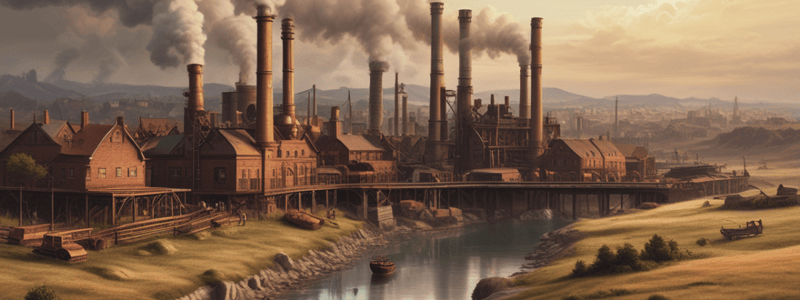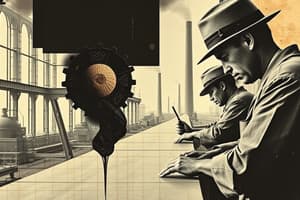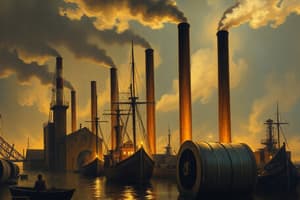Podcast
Questions and Answers
In which century did the Industrial Revolution begin in Great Britain?
In which century did the Industrial Revolution begin in Great Britain?
- 19th century
- Mid-18th century (correct)
- 17th century
- Late 20th century
Who brought a version of a textile mill from Britain to Rhode Island?
Who brought a version of a textile mill from Britain to Rhode Island?
- Eli Whitney
- Henry Ford
- Andrew Carnegie
- Samuel Slater (correct)
What was the primary crop affected by Eli Whitney's invention?
What was the primary crop affected by Eli Whitney's invention?
- Cotton (correct)
- Corn
- Tobacco
- Wheat
What was the main characteristic of the American economy before industrialization?
What was the main characteristic of the American economy before industrialization?
What was a key factor in the growth of industrialization in America?
What was a key factor in the growth of industrialization in America?
What was a significant factor in the growth of factories in the United States during the Industrial Revolution?
What was a significant factor in the growth of factories in the United States during the Industrial Revolution?
What was a major consequence of the growth of the railroad industry in the United States?
What was a major consequence of the growth of the railroad industry in the United States?
What was a major innovation in manufacturing during the Industrial Revolution?
What was a major innovation in manufacturing during the Industrial Revolution?
What was a major impact of the Industrial Revolution on urbanization?
What was a major impact of the Industrial Revolution on urbanization?
What was a major characteristic of factory life during the Industrial Revolution?
What was a major characteristic of factory life during the Industrial Revolution?
What was a major consequence of the long working hours and poor working conditions in factories during the Industrial Revolution?
What was a major consequence of the long working hours and poor working conditions in factories during the Industrial Revolution?
What was a significant impact of the growth of the railroad industry during the Industrial Revolution?
What was a significant impact of the growth of the railroad industry during the Industrial Revolution?
What was a major effect of the Industrial Revolution on American society?
What was a major effect of the Industrial Revolution on American society?
What was a characteristic of factory workers' lives during the Industrial Revolution?
What was a characteristic of factory workers' lives during the Industrial Revolution?
What was a result of the Industrial Revolution on the economy of the United States?
What was a result of the Industrial Revolution on the economy of the United States?
Flashcards are hidden until you start studying
Study Notes
Industrial Revolution in America
- The Industrial Revolution in America occurred from around 1865 to the turn of the 20th century, but its roots date back to the 1790s.
- Samuel Slater introduced a textile mill from Britain to Rhode Island, improving cotton spinning and contributing to the development of factory life in America.
Early Industrialization
- The United States had a mainly agrarian economy before industrialization.
- Industrialization gradually grew over the next several decades, expanding further due to advances in the railroad and steel industries.
- Industrialization depended on new inventions, technologies, and processes that evolved the American economy into an industrial one.
- It also relied on the labor of enslaved people, wage workers, and immigrants, who were often exploited.
Key Inventions
- The cotton gin, invented by Eli Whitney in 1794, doubled cotton production and mechanized American agriculture.
- The sewing machine, invented by Elias Howe, aided in the manufacturing of clothing and industrial growth of textile mills.
- The steam engine, introduced to the United States in the 1820s, was initially used to create rotary power from timber and water sources, and later powered boats and ships.
The Railroad Industry
- The railroad industry began in the 1820s with steam locomotives, and new railroad companies emerged to connect different trade hubs throughout the United States.
- By 1880, there were over 100,000 railways, and the country's first transcontinental railroad was completed in 1869.
- The government supported the expansion of railways across the United States, particularly with the Pacific Railway Act of 1862.
The Steel Industry
- The Bessemer Steel Process, invented in 1855, allowed for the mass production of steel.
- Steel was used to build factories and railroads, and its expansion coincided with the growth of the railroad industry.
- The steel industry continued to grow, impacting rapid urbanization and the vertical growth of cities.
Industrial Factory
- New machinery and inventions contributed to the rapid industrial revolution.
- Factories were first seen in the textile industry, built alongside rivers and other sources of water to power machinery.
- The assembly line method increased the hiring of unskilled workers and sped up production.
- Factory life was harsh and fast-paced, with workers facing long hours, poor work conditions, and low wages.
Effects of the Industrial Revolution
- The industrial revolution had long-lasting effects on the American economy, leading to population growth and booming industries.
- Child labor increased, and Americans began leaving home to work in factories.
- The industrial revolution led to a progressive era of political, social, and economic reform.
- It transformed work and day-to-day life, but also resulted in dirty and dangerous work conditions, and exploitation of workers.
Studying That Suits You
Use AI to generate personalized quizzes and flashcards to suit your learning preferences.



